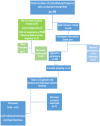Perceived Impact of Healthcare Relationships and Interactions on Parental Experiences of Prenatal Diagnosis and Termination of Pregnancy for Foetal Anomaly on the Island of Ireland
- PMID: 39428704
- PMCID: PMC11491545
- DOI: 10.1111/hex.70068
Perceived Impact of Healthcare Relationships and Interactions on Parental Experiences of Prenatal Diagnosis and Termination of Pregnancy for Foetal Anomaly on the Island of Ireland
Abstract
Objective: The aim of this study was to explore parents' experiences of their relationships and interactions with healthcare professionals (HCPs) during care related to prenatal diagnosis and termination of pregnancy for foetal anomaly (TOPFA).
Methods: A qualitative approach was used. Participants included 33 parents (23 women and 10 men) from Northern Ireland (n = 11) and Ireland (n = 22) who had a TOPFA. Data collection methods included semi-structured interviews and written narrative accounts. Data were analysed using thematic analysis.
Results: Findings confirmed that TOPFA was a traumatic, life-altering experience for parents, impacting their health and well-being. The actions, behaviours and words of HCPs impacted how parents perceived and interpreted their healthcare experiences and their access to services and supports. In relation to this, five themes are presented: (1) the importance of compassionate and non-judgemental care, (2) the value of effective information and communication, (3) the desire for compassionate care for baby and facilitation of memory making, (4) the need for continuity of care and (5) parents' experiences of healthcare relationships during times of legislative change.
Conclusion: This research reveals the important role HCPs play in helping parents cope with prenatal testing and TOPFA. Parents who had a positive relationship with an HCP, in which information was communicated effectively and compassionate and non-judgmental care was provided, felt more supported and more able to accept and adapt to their loss.
Patient and public contribution: An advisory group composed of parents who had experienced TOPFA and HCPs with experience in caring for such families were involved in the study from the outset, contributing to the design and development of data collection materials, interpretation of the findings and design of dissemination materials.
Keywords: PPIE; TFMR; TOPFA; health and well‐being; healthcare relationships; pregnancy loss.
© 2024 The Author(s). Health Expectations published by John Wiley & Sons Ltd.
Conflict of interest statement
The authors declare no conflicts of interest.
Similar articles
-
Pregnancy loss following miscarriage and termination of pregnancy for medical reasons during the COVID-19 pandemic: a thematic analysis of women's experiences of healthcare on the island of Ireland.BMC Pregnancy Childbirth. 2023 Jul 21;23(1):529. doi: 10.1186/s12884-023-05839-4. BMC Pregnancy Childbirth. 2023. PMID: 37480006 Free PMC article.
-
Experiences of prenatal diagnosis and decision-making about termination of pregnancy: A qualitative study.Aust N Z J Obstet Gynaecol. 2016 Dec;56(6):605-613. doi: 10.1111/ajo.12501. Epub 2016 Jul 12. Aust N Z J Obstet Gynaecol. 2016. PMID: 27402530
-
Termination of pregnancy for fetal anomaly: a systematic review of the healthcare experiences and needs of parents.BMC Pregnancy Childbirth. 2022 May 26;22(1):441. doi: 10.1186/s12884-022-04770-4. BMC Pregnancy Childbirth. 2022. PMID: 35619067 Free PMC article.
-
Men's experiences and need for targeted support after termination of pregnancy for foetal anomaly: A qualitative study.J Clin Nurs. 2021 Sep;30(17-18):2718-2731. doi: 10.1111/jocn.15786. Epub 2021 Apr 25. J Clin Nurs. 2021. PMID: 33899276
-
Health-care provider communication with expectant parents during a prenatal diagnosis: an integrative review.J Perinatol. 2017 Jan;37(1):2-12. doi: 10.1038/jp.2016.123. Epub 2016 Aug 11. J Perinatol. 2017. PMID: 27513325 Review.
Cited by
-
When Primary Ciliary Dyskinesia Is Diagnosed in Utero: Insights from Two Families.Adv Ther. 2025 Jul 22. doi: 10.1007/s12325-025-03298-1. Online ahead of print. Adv Ther. 2025. PMID: 40694277
References
-
- Pan M., Huang L. Y., Zhen L., and Li D. Z., “A Cost‐Effectiveness Analysis Comparing Two Different Strategies in Advanced Maternal Age: Combined First‐Trimester Screening and Maternal Blood Cell‐Free DNA Testing,” Taiwanese Journal of Obstetrics & Gynecology 57 (2018): 536–540, 10.1016/j.tjog.2018.06.011. - DOI - PubMed
-
- Ganesamoorthy D., Bruno D. L., McGillivray G., et al., “Meeting the Challenge of Interpreting High‐Resolution Single Nucleotide Polymorphism Array Data in Prenatal Diagnosis: Does Increased Diagnostic Power Outweigh the Dilemma of Rare Variants?,” BJOG 120, no. 5 (2013): 594–606, 10.1111/1471-0528.12150. - DOI - PubMed
MeSH terms
Grants and funding
LinkOut - more resources
Full Text Sources
Medical
Miscellaneous


